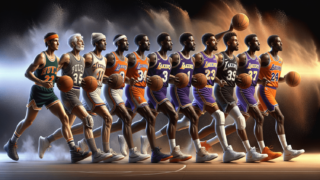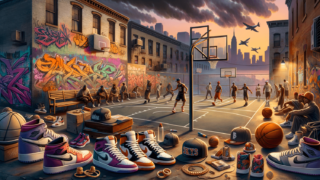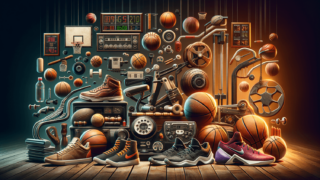
Role of Basketball in the Fight for Gender Equality
Written by: Basketball Universe
Last updated:

In the arena of sports as a catalyst for change, few games have made as big an impact as basketball, standing tall as a powerful ally in the fight for gender equality. From world-famous WNBA superstars to community-level initiatives, the sport not only challenges stereotypes, but also brings people together through its unwavering love and commitment to competition and inclusivity. So, are you ready to join us on this exciting journey as we explore the role of basketball in breaking down barriers and promoting equality? Lace-up your sneakers, keep your eyes on the prize, and read on to discover just how vital basketball has been in closing the gap and achieving a fairer, more diverse sporting landscape!
Role of Basketball in the Fight for Gender Equality
Basketball has played a significant role in the fight for gender equality by providing a platform for female athletes to excel, increasing visibility and representation of women in sports, and promoting equal opportunities at various levels of the game. Organizations like the WNBA and the NCAA work tirelessly to support women’s basketball, and numerous initiatives aim to help bridge the gap between female and male athletes. Through these ongoing efforts, basketball remains a vital force in challenging gender norms and fostering greater equality both on and off the court.
Shattering Stereotypes: Basketball’s Trailblazing Female Athletes
One cannot talk about basketball history without mentioning the incredible female athletes who have defied stereotypes and inspired a new generation of basketball fans. These trailblazing women not only excel on the court with their extraordinary talent but also pave the way for a more inclusive sporting environment. Their accomplishments have propelled women’s basketball into the mainstream spotlight, demonstrating that female athletes can perform at the highest level.
The Pioneers
The roots of women’s basketball can be traced back to the game’s earliest years, with women playing in collegiate leagues as early as 1892. Pioneering athletes, such as Nera White, dominated the national scene in the mid-twentieth century. White, a Women’s Basketball Hall of Fame inductee, was a scoring sensation and is credited with revolutionizing the women’s game during her career in the 1950s and 60s.
Breaking Barriers: The WNBA Superstars
Fast forward several decades, and the launch of the Women’s National Basketball Association (WNBA) in 1997 marked a significant advancement in women’s sports. Superstars like Lisa Leslie, Sheryl Swoopes, and Rebecca Lobo helped ensure the league’s success, thanks to their athletic prowess and marketability. They challenged societal expectations and inspired countless girls to dream big, conveying the message that opportunities in sports are not limited by gender.
Today’s Basketball Icons
Modern-day players like Diana Taurasi, Candace Parker, Elena Delle Donne, and Breanna Stewart have continued the legacy of their predecessors, proving that female basketball players are equally talented and deserving of recognition. These exceptional athletes also use their platforms to address gender inequality, from advocating for equal pay to increasing visibility for women’s sports.
The WNBA: A Driving Force for Gender Equality
The Women’s National Basketball Association (WNBA) has played a pivotal role in shattering glass ceilings and creating opportunities for female basketball players. As the longest-running women’s professional basketball league, the WNBA showcases the immense talent of its players while advocating for equal opportunity, both on and off the court.
Salary Disparities & Collective Bargaining
Despite significant strides, salary disparities between the NBA and WNBA remain a persistent concern. WNBA players have stood united in demanding equal pay for equal play, urging for change through collective bargaining agreements. The 2020 CBA marked a significant victory, with landmark provisions for increased player compensation, improved travel accommodations, and enhanced maternity and family leave benefits. These steps demonstrate that the WNBA and its players are actively working together in addressing the pay gap and promoting gender equality.
Supporting Critical Social Issues
In addition to their contributions on the court, WNBA players consistently use their voices and influence to advocate for social justice and gender equality. From partnering with organizations like Planned Parenthood to standing at the forefront of movements addressing social inequalities, the league’s commitment to equal rights and opportunities is unwavering. It is this fusion of sport and activism that sets the WNBA apart and makes it a powerful ally in the fight for a more diverse and inclusive sporting landscape.
Empowering the Next Generation: Grassroots Initiatives
Promoting gender equality in basketball extends far beyond the professional level. Grassroots organizations play a critical role in empowering girls and women through the sport, creating opportunities on the court and fostering leadership skills that can transfer to other areas of life.
Girls’ Basketball Leagues & Programs
Community-based leagues and youth programs are essential in providing girls with opportunities to play basketball at an early age. Organizations like Girls Inc. and the Women’s Sports Foundation offer basketball programs that encourage girls to be active and develop their skills. They often provide scholarships and grants to promote the sport in underrepresented communities, emphasizing the importance of equal access to sporting opportunities.
Basketball Camps & Clinics
Attend a summer camp or clinic, and you’ll witness first-hand the impact these programs have on girls’ development on and off the court. Through education and skill development, camps and clinics like Point Guard College and Breakthrough Basketball empower young girls, providing them with a supportive environment to hone their abilities and grow their love for the game.
NCAA’s Role in Promoting Women’s College Basketball
The National Collegiate Athletic Association (NCAA) also plays a crucial role in promoting women’s basketball, offering scholarships and organizing competitive leagues for female athletes. The NCAA Women’s Final Four tournament is a prime example of their commitment to gender equality, making it a marquee event designed to showcase the extraordinary talent of college-level female basketball players.
Achieving Equal Representation: Coaching & Management Opportunities
For gender equality in basketball to be fully realized, opportunities must extend beyond the players themselves. Ensuring equal representation in coaching and management positions is of paramount importance, as these decision-makers profoundly impact the sport’s future direction.
Female Coaches Breaking Boundaries
While the percentage of female coaches in women’s basketball is higher than in many other sports (especially at the college level), there is still progress to be made. Notable female coaches like Pat Summitt, Tara VanDerveer, and Dawn Staley have not only achieved success on the court but have also broken boundaries by becoming renowned figures in the sport. Their impact cannot be overstated, as they serve as role models for aspiring young coaches and athletes alike.
Basketball Management: Closing the Gender Gap
Another critical aspect of gender equality in basketball is closing the gender gap in management and executive roles. The appointment of Cathy Engelbert as the first-ever Commissioner of the WNBA in 2019 marked a significant step forward in achieving gender diversity in basketball’s leadership. Additionally, organizations like the NBA’s Women’s Leadership Initiative aim to strengthen the league’s commitment to diversity and inclusion, fostering a more equitable workplace for women in sports management.
As we’ve seen, basketball’s role in the fight for gender equality extends far beyond the court. The sport unites, inspires, and impacts countless lives through the unwavering commitment of its athletes, organizations, and grassroots initiatives to creating a more inclusive and diversified landscape for the love of the game. Together, we can continue to challenge the norms and work towards a future where basketball truly belongs to everyone.
Creating Allies: Men’s Involvement in the Fight for Gender Equality in Basketball
Men’s involvement in advocating for gender equality is crucial to drive change and create a more inclusive environment in basketball. By supporting women and acknowledging the importance of equal opportunities and fair representation in the sport, male basketball players, coaches, executives, and fans can contribute significantly to this critical issue.
Male Athletes as Advocates
Several high-profile male basketball players have taken on the mantle of advocating for women’s basketball and gender equality. LeBron James, Stephen Curry, and even retired legends like Dwyane Wade and Kobe Bryant have used their platforms to voice their support for female athletes, the WNBA, and women’s basketball in general. By attending WNBA games, promoting the league, and engaging in initiatives that strive for equality, these athletes help ensure that women’s basketball receives the recognition and admiration it deserves.
Supportive Coaching Relationships
Coaching relationships are also crucial in fostering a more equitable environment in basketball. With more men getting involved in coaching women’s basketball, mindsets can change and barriers can break down. Notable male coaches like Geno Auriemma and Muffet McGraw have made significant contributions to women’s basketball, guiding their teams to national championships and advocating for gender equality in the sport, both by hiring diverse coaching staffs and consistently supporting their players and colleagues.
Policy Changes & Organizational Support
Policy changes within basketball organizations are instrumental in creating a more inclusive environment. In recent years, more NBA teams have started to hire women in various roles, such as coaching, scouting, and analytics. By providing women with equal opportunities to grow in the sports industry, these organizations demonstrate that they are committed to fostering an inclusive and supportive environment.
Men as Fans & Supporters
Last but not least, the support of male fans is vital to the growth and development of women’s basketball. Men who attend WNBA games, follow women’s college basketball, and appreciate the sport as equally competitive and skillful contribute to the fight for gender equality by challenging societal expectations and encouraging others to support women’s basketball.
Men’s involvement in promoting gender equality is essential to creating a more inclusive and supportive environment within basketball. By acknowledging the power of diverse representation and working together, the basketball community can achieve even greater heights in the fight for gender equality.
FAQ: Gender Equality in Basketball
Do you have questions about gender equality in basketball? You’re not alone! Check out our helpful FAQ section that answers some of the most common questions related to this crucial topic in sports.
1. When was the WNBA established, and how many teams are in the league?
The Women’s National Basketball Association (WNBA) was established on April 24, 1996, with the first season played in 1997. Currently, the league consists of 12 teams.
2. How do WNBA player salaries compare to NBA player salaries?
WNBA player salaries are significantly lower than NBA player salaries. Despite recent improvements made in the 2020 Collective Bargaining Agreement (CBA), the average WNBA salary still stands at around $130,000, while the average NBA salary is approximately $7.7 million.
3. What are some ways to support women’s basketball?
Ways to support women’s basketball include attending games, watching televised games, purchasing merchandise, following female athletes on social media, and spreading the word about the sport among family and friends. Supporting grassroots initiatives and programs aimed at empowering girls and women through basketball is another great way to strengthen the foundation of the sport.
4. How have notable male basketball players supported women’s basketball and gender equality?
Notable male basketball players like LeBron James, Stephen Curry, Dwyane Wade, and the late Kobe Bryant have voiced their support for women’s basketball, attended WNBA games, promoted the league, and encouraged their fans to appreciate and support women’s basketball as well. By using their platforms, they contribute significantly to the fight for gender equality in sports.
5. What is the significance of the 2020 Collective Bargaining Agreement (CBA) in the WNBA?
The 2020 CBA represented a significant step forward for the WNBA, addressing salary disparities and working conditions for players. The agreement included increased player compensation, improved travel accommodations, and enhanced maternity leave and family benefits, among other provisions. This milestone marked substantial progress in promoting gender equality within basketball.
6. Which college basketball coach has the most NCAA Women’s Championship titles?
Geno Auriemma, the head coach of the University of Connecticut (UConn) women’s basketball team, currently holds the record for the most NCAA Women’s Championships titles, with 11 championships to his name.
7. How have female coaches made an impact in men’s basketball?
Female coaches have started to break barriers and make an impact in men’s basketball, with notable examples including Becky Hammon, an assistant coach for the San Antonio Spurs, and Nancy Lieberman, a former assistant coach for the Sacramento Kings. Their hiring demonstrates that gender should not be a limiting factor for knowledge, expertise, and coaching ability in basketball.
8. Are there any professional women’s basketball leagues outside the United States?
Yes, there are several professional women’s basketball leagues worldwide. Some prominent examples include EuroLeague Women, Liga Femenina de Baloncesto (Spain), Women’s Chinese Basketball Association (WCBA), and Women’s Korean Basketball League (WKBL), among others.
9. How do college basketball scholarships work for women?
College basketball scholarships for women are awarded by institutions under the jurisdiction of the National Collegiate Athletic Association (NCAA), National Association of Intercollegiate Athletics (NAIA), or National Junior College Athletic Association (NJCAA). Full or partial scholarships may cover tuition fees, room and board, and other educational expenses. NCAA Division I and II schools provide over 3,000 scholarships opportunities for women’s basketball annually.
10. Which famous document impacted gender equality in sports, including basketball?
Title IX, a federal law enacted in the United States in 1972, has had a lasting impact on gender equality in sports, including basketball. Title IX mandates that educational institutions receiving federal financial assistance may not discriminate based on sex. This law has led to an increase in athletic opportunities for women and girls over the past decades, and it remains a guiding legal document in the ongoing push for gender equality in sports.
Featured Posts
- No pillar pages found.





